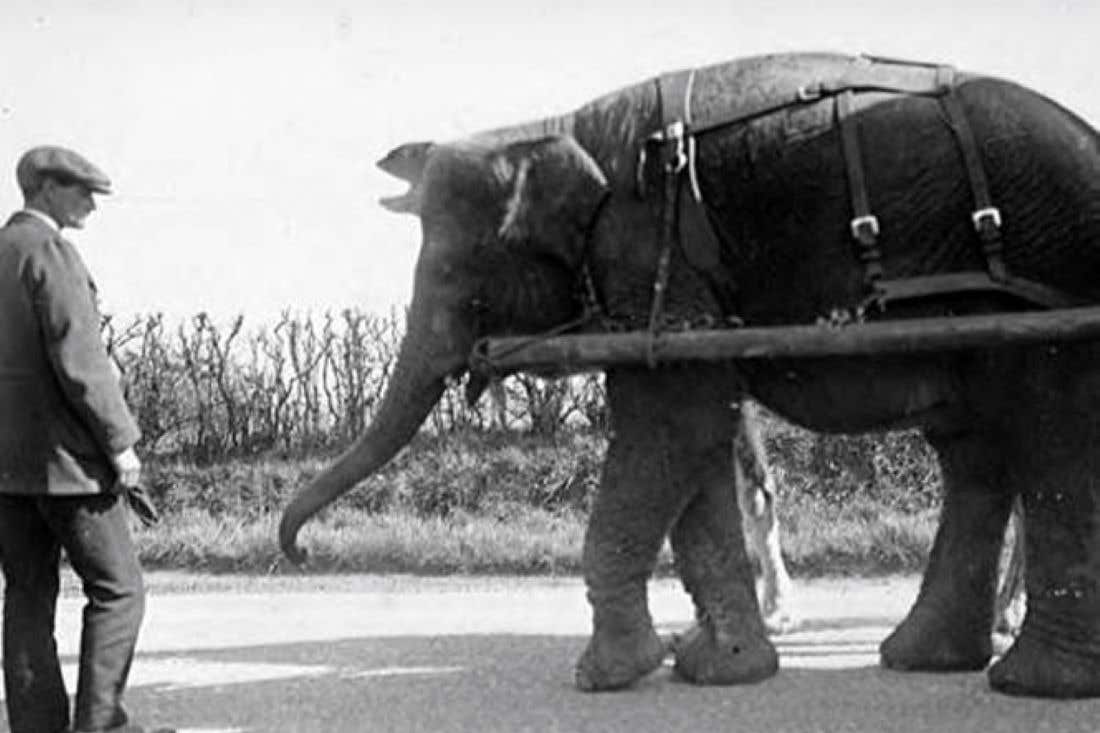People have spent years searching for England’s buried elephants – they might finally have an answer
Local legends say elephants from travelling ‘wild beast’ shows like Bostock and Wombwell’s Menagerie, were buried across the country

Etched in local memory for generations, the tale of Nancy the circus elephant says that she died from yew leaf poisoning on the outskirts of Bristol 130 years ago, and was buried outside a church.
There are no traces of either the death or burial in newspapers from the time, but that didn’t stop the story from becoming part of the history of the town of Kingswood, where elephants can still be seen on plaques and in the local museum.
Nancy was said to have been part of Bostock and Wombwell’s Menagerie, a travelling exhibition of exotic animals from around the world.
Now though, the legend is looking increasingly like an urban myth after an archaeological group failed to find any evidence of elephant remains during a recent ground survey close to the town’s high street.
“The story was probably put together by people in the pub during Victorian times and it’s stuck,” says Alan Bryant, curator at Kingswood Museum, who first heard about the burial while a milkman in the area in the 1970s.
“It’s lovely to have the story as part of the history of Kingswood, but the outcome hasn’t surprised me because it really didn’t make sense. Surely they’d have cut up the animal to feed to the lions?
“I’ve put it down to one of those silly things people come up with and over the years it continues to get talked about, and then believed.”
Yet this story of a legendary elephant burial is nothing new in the UK. There are various accounts of such graves from Victorian times, most of them deemed to be nothing more than urban myths.
In the Lincolnshire village of Aswarby, an American circus elephant is said to have been buried opposite a pub. It’s been claimed the animal was part of a touring circus before it died in around 1892.
No trace has ever been found in Lincholnshire Archives, although the mammal featured in an exhibition celebrating the 250th anniversary of the circus at the National Centre for Craft and Design in nearby Sleaford five years ago.
In Diss, Norfolk, another circus elephant, named Madame Abdella, is said to have been laid to rest in an area called Fair Green in around 1867. The 20-year-old Burmese was thought to have been brought to the town as part of a travelling circus, but unexpectedly died.
Legend has it she was buried in the area, cementing her place in Diss folklore. This year, locals took part in an arts project funded by the National Lottery Heritage Fund to celebrate the story.
In Coleshill in Warwickshire, a statue was unveiled of an elephant five years ago to commemorate the story of one that was supposedly buried under a Morrisons supermarket in the town in 1911. The story goes that the elephant died choking on a root vegetable while being walked with a travelling circus from a nearby village.
It’s claimed that the animal collapsed outside a pub and was buried in a nearby open space. Work on the Morrisons supermarket was put on hold to search for the elephant’s grave, but no remains were found.
And in Scotland, there are rumours of an elephant being buried under a bar in the heart of Glasgow. The legend states that the elephant was parading the city’s streets when it collapsed on Kelvinbridge and died in the early 20th Century.
Being too heavy to move, the animal was pushed over the bridge into a grave beneath. A bar and restaurant called The Big Blue later opened over the grave, and the legend of The Elephant under The Big Blue was born, although the pub is now called Inn Deep.
“These stories are given birth during the Victorian age when such large animals were considered exotic and the people were fascinated by them,” says circus historian Dr Steve Ward. “Today we can see these animals on television or in a zoo. Back then there would have been an air of mystery about them and so stories about their burials would have been formed.”
Dr Ward says he had doubts over the prospect of finding Nancy’s remains in Kingswood having trawled through newspaper archives and finding no mention of the animal’s death or burial.
Research did show, however, that the elephant was a highlight of the Bostock and Wombwell’s Menagerie, described as “the oldest, largest and best travelling exhibition ever organised”. And advertising posters show it was in the Bristol region around 1891 - when Nancy was said to be buried.
But the evidence stops there, even after a radar survey by Wessex Archaeology which was done on behalf of South Gloucestershire Council for £4,400.
At Kingswood Museum, Mr Bryant sees the funny side of the situation. “We have eleven elephants on display which we challenge people to find around the museum - and that is the only place you’ll likely find an elephant in Kingswood.”
Subscribe to Independent Premium to bookmark this article
Want to bookmark your favourite articles and stories to read or reference later? Start your Independent Premium subscription today.

Join our commenting forum
Join thought-provoking conversations, follow other Independent readers and see their replies